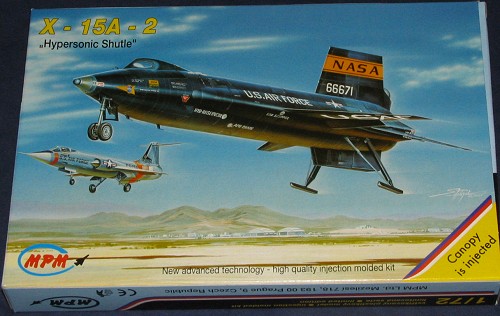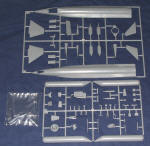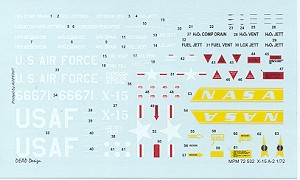
| KIT: | MPM 1/72 North American X-15A-2 |
| KIT #: | 72532 |
| PRICE: | $ |
| DECALS: | One option |
| REVIEWER: | Scott Van Aken |
| NOTES: |

| HISTORY |
The ultimate manned research aircraft has to be the X-15. It is a plane that fired the imagination of many youth (including this one), spawned a number of astronauts, and gave high speed manned aviation research its final hoorahs.
Developed specifically to see how high and how fast a man and machine could travel in an aircraft, the first powered flight in September of 1959 with Scott Crossfield at the controls. He reached a speed of nearly 1,400 mph and an altitude of 37,000 feet on that flight. It actually was the 8th time he had been airborne in an X-15 for scheduled captive and free fall flights, but most of those ended back at base after systems failures.
Interestingly, this first powered flight was made in X-15 #2, while the last powered flight was made in October 1969 by aircraft #1. At that time it reached a height of 250,000 feet and a speed of 3,682 mph. In those ten years and 199 official flights, much was learned and much was modified on the X-15.
The ultimate version of the X-15 was the X-15A-2. This was aircraft #2 that had been damaged in an overweight landing that resulted in the aircraft landing gear collapsing and the aircraft rolling at touchdown. The NASA Pilot John McKay was injured and returned to test flying six months later, but his injuries were later the cause of his leaving NASA and test flying.
It was then decided to modify aircraft #2 by extending the fuselage to make room for more fuel and to allow it to carry external tanks for the initial boost phase up past Mach 2. Although it flew a number of flights above the design speed of Mach 6, the highest achieved speed was Mach 6.70 or 4,520 mph reached in October of 1967 with flight #188. This was with the aircraft coated in a white ablative material to protect the plane at high speed. The maximum altitude was achieved 354,000 feet on flight #91 in August of 1963. To be qualified for astronaut wings the pilot has to achieve an altitude of over 264,000 feet or 50 miles. Dozens of flights were made to that altitude and a number of X-15 pilots achieved their astronaut wings.
Only two of the three X-15s survived. During a November 1967 flight, #3 skewed sideways by overcorrection at a speed of Mach 5 while at 233,000 feet. It then entered a spin and when it reached lower levels the air pressure was enough to cause the plane to exceed maximum g loads and it disintegrated in flight, killing Air Force pilot Michael Adams. #1 is with the Smithsonian Collection and #2, the A-2, is with the USAF Collection at Wright-Patterson AFB in Ohio.
| THE KIT |
 The first thing that struck me when
opening the box was that there was no etched brass, no resin, and no
vacuformed parts. One thing you can say about MPM is that they are darn
close to being one of the 'big boys' in terms of the makeup of their kits.
They have nearly left the realm of short run with the majority of their new
kits and this is one that takes them even closer.
The first thing that struck me when
opening the box was that there was no etched brass, no resin, and no
vacuformed parts. One thing you can say about MPM is that they are darn
close to being one of the 'big boys' in terms of the makeup of their kits.
They have nearly left the realm of short run with the majority of their new
kits and this is one that takes them even closer.
There are three sprues of plastic with finely engraved panel lines. One of these sprues is quite small and consists of the clear bit. Actually, the entire canopy section is clear, so all one has to do is mask off the window. Parts not used are for the scram-jet as the kit includes the additional fuel tanks used in later flights.
The X-15 is really a pretty simple
aircraft when one gets down to it. MPM has provided a cockpit tub into
which a seven piece seat is fitted. There is also a control stick and
instrument panel. Unlike the 1/48 kit, it a ppears
that one can build this kit with the aft landing skids in the down
position. Of course, this means you can't attach the lower fin extension,
but to display it in flight, you'd have to build a stand for it.
ppears
that one can build this kit with the aft landing skids in the down
position. Of course, this means you can't attach the lower fin extension,
but to display it in flight, you'd have to build a stand for it.
Instructions are well done and provide generic color information during the build process. I'd like to have seen a side view of how the landing skid look in the lowered and raised position as the instructions don't provide that info. The painting and decals guide seems to have come from the 1/48 kit as it shows the X-15 on its handling trolley, an item not included in this kit. The decal sheet is quite extensive and offer both early and later markings for the aircraft. My experience with MPM decals has been excellent and these should work very well indeed.
| CONCLUSIONS |
This latest kit just adds to the variety of neat stuff MPM has done. X-craft fans will undoubtedly want one for their collections and it will make for a fine display model. Its general lack of fiddly parts would make this acceptable for those beginners who have a few glue kits under their belts and want to try something a bit more challenging.
July 2005
Review kit courtesy of MPM.
If you would like your product reviewed fairly and quickly by a site that has around 300,000 visitors a month, please contact me or see other details in the Note to Contributors.